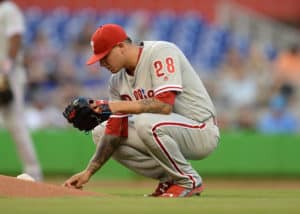

So much for avoiding the mistakes that helped make 2019 a mediocre season for the Philadelphia Phillies.
Last year, Matt Klentak and the Phillies decided to enter the season with a rotation that featured the trio of Zach Eflin, Vince Velasquez and Nick Pivetta, hoping that at least one of them would break out and none would regress. While Eflin had an overall solid season, Pivetta and Velasquez both struggled and the team’s plan backfired.
Although it looked like the Phillies were going to try to acquire two starters this offseason, they have signed only one, Zack Wheeler, and have little room left before exceeding the luxury tax. Other accomplished free agent starters – like Madison Bumgarner, Hyun-jin Ryu and Dallas Keuchel – have all been signed. And cheaper options, like Michael Pineda and Kyle Gibson, were signed at relatively high average annual value (AAV) that the Phillies were not in on.
Now, with just a few free agents left unsigned and little money before exceeding the luxury tax, the Phillies rotation appears to be set. And, despite improving with the Wheeler signing, the rotation appears to share many of the same question marks as the 2019 rotation that so badly underperformed.
The biggest one? Right-handed pitcher Vince Velasquez.
Velasquez came to the Phillies in the Ken Giles trade with the Houston Astros in December 2015. He made a brilliant first impression, pitching a complete game, 16-strikeout shutout in just his second start with the team. But after a promising start to his career as a Phillie with a solid 2016, Velasquez has been unable to find consistency as a major league starter.
Despite this, Velasquez is the favorite to start the season in the rotation. The Phillies believed enough in Nick Pivetta to name him their No. 2 starter heading into 2019, but a completely lost season has changed things. Top prospect Spencer Howard is likely to start the season in Triple-A. Other back-end guys like Cole Irvin and Enyel De Los Santos have not had any success in short major league stints in the starting rotation. Velasquez has the experience, and despite his inconsistency, is likely the best man for the job among the Phillies current options.
Over the last several seasons, the selling point on Velasquez has been his potential. His fastball is an above average pitch, but his failure to solidify a consistent breaking ball has plagued him, causing frequent deep counts and subsequent short outings. He has had a 4.96 ERA over the past three seasons, a dreadful number that is the 10th worst among all qualified MLB starters during that time.
While he has been a relatively solid option when facing an opposing lineup for the first two times in a game, Velasquez has been horrible when facing them for the third time. This was especially true in 2019, when Velasquez’s 1.380 OPS against then facing an opposing lineup for the third time was the fourth worst in MLB history (minimum 60 batters faced).
Adapting for this and changing how Velasquez is used in 2020 could help the 27-year-old to be a more competent and consistent pitcher. One option would be using an opener for Velasquez, so that he enters the game in the second or third inning and will begin his outing facing weaker hitters in the opposing lineup. This is a strategy that has been used successfully by the Tampa Bay Rays, and could prove useful for Velasquez and the Phillies.
The Phillies undoubtedly have better rotation depth than last season, especially with Howard likely ready to make his debut at some point this season. But it is becoming increasingly likely that they will again be relying on Velasquez to make a fair amount of starts. It would behoove them to adjust how they use him based on four seasons of evidence.